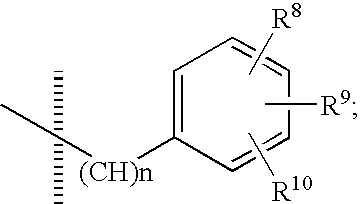Dihydroindol-2-one derivatives as steroid hormone nuclear receptor modulators
a technology of steroid hormone and nuclear receptor, which is applied in the direction of metabolism disorder, extracellular fluid disorder, immune disorders, etc., can solve the problems of increased melanin pigmentation of the skin, muscle weakness, hypertension, etc., and achieves the effects of increasing the number of patients
- Summary
- Abstract
- Description
- Claims
- Application Information
AI Technical Summary
Benefits of technology
Problems solved by technology
Method used
Image
Examples
preparation 1
3,3-Bis-(4-Hydroxy-3,5-dimethyl-phenyl)-1,3-dihydro-indol-2-one
[0462]
[0463]Reference: Song, H. N., et. al.; Syn. Comm. (1999), 29, 3303-3311.
[0464]Under a nitrogen atmosphere, combine isatin (57.30 g, 389.5 mmol) and 2,6-dimethyl phenol (99.92 g, 817.9 mmol) in glacial acetic acid (1 L) to form a bright-orange suspension. Add AlCl3 (129.82 g, 973.6 mmol) in 4 portions as the mixture exotherms. Heat the reaction to 90° C. for 3 h. Monitor by TLC (5% MeOH / CH2Cl2, UV). Cool to room temperature, pour onto ice, filter, wash with H2O and vacuum dry (40° C.) to yield 125 g (86%) of the title compound as a tan solid. MS (ES): m / z=374 (M+1), 372 (M−1); NMR (DMSO-d6) δ 10.49 (s, 1H), 8.17 (s, 2H), 7.18-7.15 (m, 2H), 6.96 (m, 1H), 6.87 (m, 1H), 6.66 (s, 4H), 2.05 (s, 12H).
preparation 2
3,3-Bis-[4-(tert-butyl-dimethyl-silanyloxy)-3,5-dimethyl-phenyl]-1,3-dihydro-indol-2-one
[0465]
[0466]Combine 3,3-bis-(4-hydroxy-3,5-dimethyl-phenyl)-1,3-dihydro-indol-2-one(125 g, 334.7 mmol), tert-butyldimethylsilyl chloride (126.13 g, 836.8 mmol) and imidazole (91.15 g, 1.34 mol) in dry DMF (1.5 L). Flush the mixture with nitrogen and stir at room temperature 18 h. Monitor by TLC (5% MeOH / CH2Cl2 for starting material, 50% EtOAc / hexane for product, UV detection). Filter off the resulting solid, dissolve in CH2Cl2, wash with H2O (2×), and brine. Then dry (Na2SO4), filter and concentrate in vacuo to yield 68.7 g of a white solid. Concentrate in vacuo the DMF filtrate from the original reaction, add CH2Cl2 to dissolve the solids, wash with H2O and brine. Then dry and concentrate to yield an orange solid. Add CH2Cl2 again to precipitate out a solid. Wash the material with CH2Cl2, and dry to yield 24.8 g of a white solid. Concentrate the CH2Cl2 wash portion to yield 80 g of a yellow soli...
preparation 3
3,3-Bis-(4-hydroxy-phenyl)-1,3-dihydro-indol-2-one
[0467]
[0468]Using a method similar to Preparation 1, with isatin (1.44 g, 10 mmol) and phenol (1.88 g, 20 mmol) gives 502 mg (16%) of the title compound. MS (ES): 318 (M+H), 316 (M−H); NMR(DMSO-d6): δ10.60 (s, 1H), 9.42 (s, 2H), 7.25-7.14 (m, 2H), 7.03-6.91 (m, 6H), 6.70 (d, J=8.5 Hz, 2H).
PUM
 Login to View More
Login to View More Abstract
Description
Claims
Application Information
 Login to View More
Login to View More - R&D
- Intellectual Property
- Life Sciences
- Materials
- Tech Scout
- Unparalleled Data Quality
- Higher Quality Content
- 60% Fewer Hallucinations
Browse by: Latest US Patents, China's latest patents, Technical Efficacy Thesaurus, Application Domain, Technology Topic, Popular Technical Reports.
© 2025 PatSnap. All rights reserved.Legal|Privacy policy|Modern Slavery Act Transparency Statement|Sitemap|About US| Contact US: help@patsnap.com



